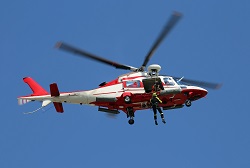Enhanced helicopter navigation promises to save more lives
Helicopters have long been used in emergency operations, but still face many challenges ranging from lack of coordination to bad weather. Helicopter rescue operations are often unregulated, while existing onboard satellite technology remains underused to a large extent. The EU-funded 5 LIVES project aimed to exploit the European Global Navigation Satellite Systems (EGNSS) services, EGNOS and Galileo, to improve the success of emergency missions. “This can be achieved by enhancing pilot navigation to achieve 24/7 emergency medical operations and advancing onboard real-time monitoring and tracking to rescue firefighters in distress,” says Santiago Soley, CEO of PildoLabs, a 5 LIVES consortium partner. Overcoming limitations in navigation While helicopters usually represent the most efficient means for providing urgent medical transport, safe navigation depends on good visibility, daylight hours and good weather. Such limitations can be overcome using EGNSS services which can facilitate night-time flying significantly and help navigate through adverse weather conditions. “The probability of saving lives in such situations depends largely on responding within the so-called golden hour, which means that flying in adverse weather or at night are pivotal for saving lives,” notes Soley. In many remote areas, helicopters are the only way to access crucial medical services. “EGNSS can help bring efficient 24/7 service to any European citizen, reducing the time required to transfer patients directly to hospital without any need for costly on-ground navigational equipment.” Not only will medical assistance benefit from more efficient helicopter service, but so will other emergency situations such as firefighting. “Providing EGNSS-based low level routes can assure pilots’ safe return to the helicopter base at sunset, and in the future even enable continuous fire extinction and monitoring operations at night,” asserts Soley. With the adequate systems, situational awareness for ground brigades will also be improved, enabling rapid rescue and minimising the risk of loss of life during transport. EGNSS also provides an opportunity to improve the provision of cross-regional and transnational services, enhancing cooperation between EU Member States for implementing combined operations that benefit European citizens regardless of nationality. New onboard system to support pilots 5 LIVES has upgraded existing portable flight validation equipment known as PLATERO to develop what it calls PLATERO-MCS, a prototype representing onboard equipment to support pilot operations during a mission. “Integrating different layers of information through electronic portable equipment will help pilots conduct maritime search and rescue, as well as advance firefighting, in a safer and more efficient manner,” reveals Soley. The portable platform, which will be installed aboard helicopters independently from any existing avionics, is enhanced with a powerful software package. “It offers an interface to properly manage the flight campaign and logs all necessary data to generate the flight validation report automatically,” explains Soley. The data can be stored on the cloud for any possible further assessment. The overall product package, comprising the hardware and software equipment, is marketed under a Software as a Service agreement scheme, granting access to the cloud reporting web service. It is worth noting that PLATERO-MCS is being deployed and tested aboard firefighting helicopters in Galicia, north-west Spain in summer 2018. Commercialisation is expected to take place in 2019, paving the way to additional onboard equipment that will support helicopter pilot operations. Lastly, the first PLATERO-MCS prototype could be exploited to support not only helicopter operations but eventually also future remotely piloted aircraft systems services.
Keywords
5 LIVES, helicopter, EGNSS, firefighting, satellite technology, search and rescue, medical transport







